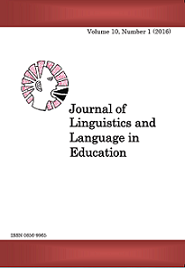Topic Change as a Conversational Strategy in Police-Suspect Interaction in Ibadan, Nigeria
Abstract
Police-Suspect interaction, henceforth PSI, is a form of forensic discourse. It is a relatively new area in language study. Existing studies have illuminated police discourse from the non-linguistic perspective. Such studies have not investigated the import of topic change in police interrogation. Studies on police interrogation, from the linguistic angle, still beg scholarly attention. To extend the frontiers of existing linguistic engagement of police interrogation, this study examines the significance of topic change as conversational strategy in police-suspect interaction with a view to uncovering the motivation for topic change and its implication on the interrogation process. Using conversational analysis as its theoretical anchor, interrogation sessions on burglary and stealing, murder, physical abuse, felony, robbery and malicious damage were tape-recorded at the State Criminal Investigation Department, Ìyágà nkú, Ibadan, Oyo State. The nonparticipant observation technique was adopted. Interrogating police officers, henceforth IPOs, and suspects change interrogation topics through the deployment of interrogatives, the bridge technique, making reference to earlier topics, summoning, deflection and giving compliments and seeking advice. Apart from serving pedagogical significance, the discourse analytical approach to police interrogation provokes a better understanding of how PSI works. The study reveals that topic change remains a viable tool for stamping the motivations of IPOs and suspects during interrogation sessions. A study of topic management in PSI reveals how power is enacted and managed in PSI.
Key words: topic change, conversational strategy, conversational analysis, police-suspect, interrogation power
References
Akinrinlola, T. (2018). Turn Management Strategies in PoliceSuspect Interaction in Ibadan, Nigeria. The Quint, 10(3): 146 €“177.
Akinrinlola, T. (2017). Deception in Police-Suspect Interaction in
Ibadan, Nigeria. Journal of Pan African Studies, 10(1): 1 €“21.
Akinrinlola, T. & Ajayi, T. (2016). The Pragmatics of Hedges in
Police-Suspect Interaction in Ibadan. Manuscript accepted for
publication for Festschrift in Honour of Professor Akin Odebunmi, Department of English, University of Ibadan, Nigeria.
Bowles, H. (2011). The Contribution of Conversational Analysis to
Literary Dialogue. Nontas Royal Research of Youth and Language, 5(1): 161 €“168. Retrieved from Hp.//www.novtasasroyal.org
Brown, A. (2003). Interviewer Variation and the Co-construction of Speaking Proficiency. Language Testing, 20(1):1 €“25.
Brown, G. & Yule, G. (1983). Discourse Analysis. Cambridge:
Cambridge University Press.
Cossin, A. (2009). Cross-examination in Child-centered Assault Trial: Evidentially Safeguard or an Opportunity to Confess?
Melbourne: Melbourne University Press.
Coulthard, M. (1985). An Introduction to Discourse Analysis. Harlow: Longman.
Drew, P. & Hentage, J. (1992).Talk at Work: Interaction in Institutional Setting. Cambridge: Cambridge University Press.
Fairclough, N. (1992). Discourse and Social Change. Cambridge:
Cambridge University Press.
Farinde, R. O. (2008). Forensic Linguistics: An Introduction to the
Study of Language and the Law. Ago-Iwoye: Olabisi Onabanjo
University Press.
Farinde, R. O. (2010). Forensic Linguistics: Power and Asymmetries in the Nigerian Courtroom Discourse. Unizik Journal of Arts and Humanities, 11(2): 40 €“69.
Garfinkel, H. (1964). Studies in the Routine Grounds of Everyday
Activities. Social Problems, 2 (1): 225 €“250.
Gordon, F. (2012). Effective Interviewing and Interrogation
Techniques. London: Academic Press.
Heffer, C. (2010). The Language of Jury Trial: A Corpus-aided
Analysis of Legal Discourse. Basingstoke: Palgrave Macmillan.
Heydon, G. (2005). The Language of Police Interviewing: A Critical
Discourse Analysis. Basingstoke: Plagrave.
Hentage, J & Clayman, S. (2010). Talk in Action---Interaction and
Identities and Institutions. United Kingdom: Wiley Blackwell.
Hobbs, P. (2003). You Must Say it for him: Reforming a Witness
Testimony on Cross-Examination at Trial. Text, 23(4): 477 €“511.
Hutchby, I. & Wooffit, R. (2008). Conversation Analysis. ambridge.
Cambridge Polity Press.
Koshik, I. (2003). Wh-questions Used as Challenges. Discourse
Studies, 5(1): 51 €“77.
Liddicoat, A. J. (2007). An Introduction to Conversation Analysis.
London: Continuum.
Luchjenbroers, J. (1997). In Your Own Words €¦ Questions and
Answers in a Supreme Court Trial. Journal of Pragmatics,
(2): 471 €“503.
Newbury, P & Johnson, A. (2006). Suspects Resistance to
Constraining and Coercive Questioning Strategies in the
Police Interview. The Journal of Speech, Language and the
Law, 13(2): 213 €“240.
Nicola, S. N. (2012). Discourse of Rape. London: Routledge.
Opeibi, T. (2008). A Study of Interrogatives in Selected Nigerian
Courtroom Discourse. In O. Francis, A. Lorz & D. Stein (eds.).
Law and Language: Theory and Society. Dusseldorf:University of Dusseldorf Press: 147 €“176.
Osisanwo, W. (2003). Introduction to Discourse Analysis and
Pragmatics. Lagos: Femolus-Fetop Publishers.
Sacks, H. (1992). Lectures on Conversation. Oxford: Basil Blackwell.
Sack, H. & Schegloff, E. A. (1973). Opening and Closing. Semiotica, 8(4): 289 €“327.
Sacks, H., Schegloff, E. A. & Jefferson, A. (1974). A Simplest
Systematics for the Organization of Turn Taking for
Conversation. Language, 50(4): 696 €“735.
Seehouse, P. (2011). Conversation Analysis Research into Language Teaching and Learning. In Hinkel (ed.). The Handbook of Research in Second Language Teaching and Learning, 2(1):
€“363.
Sidnel, J. (2010). Conversation Analysis: An Introduction. West
Sussex, United Kingdom: Wiley Blackwell.
Sunday, A. B. & Akinrinlola, T. (2017). Negotiation Tactics in PoliceSuspect Interaction in Ibadan, Nigeria. Journal of Communication and Language Arts, 8(1): 161 €“181.
Thornborrow, J. (2007). Narratives, Stance and Situated Arguments in Talk Show Discourse in Kilney. Journal of Pragmatics, 39(2): 1436 €“1453.
Zimmerman, D. H. & West, C. (1975). Sex Roles, Interruption and
Silences in Conversation. Language and Sex: Difference and
Dominance. Stanford: Stanford University Press.
Downloads
Published
Issue
Section
License
Copyright © by Department of Foreign Languages and Linguistics, University of Dar es Salaam
All rights reserved. No part of this publication may be reproduced or transmitted in any form or by any means, electronic or mechanical, including photocopying, recording, or any information storage or retrieval system, without permission in writing from the publisher, except for short extracts in fair dealing, for research or private study, critical scholarly review or discourse with an acknowledgement.



